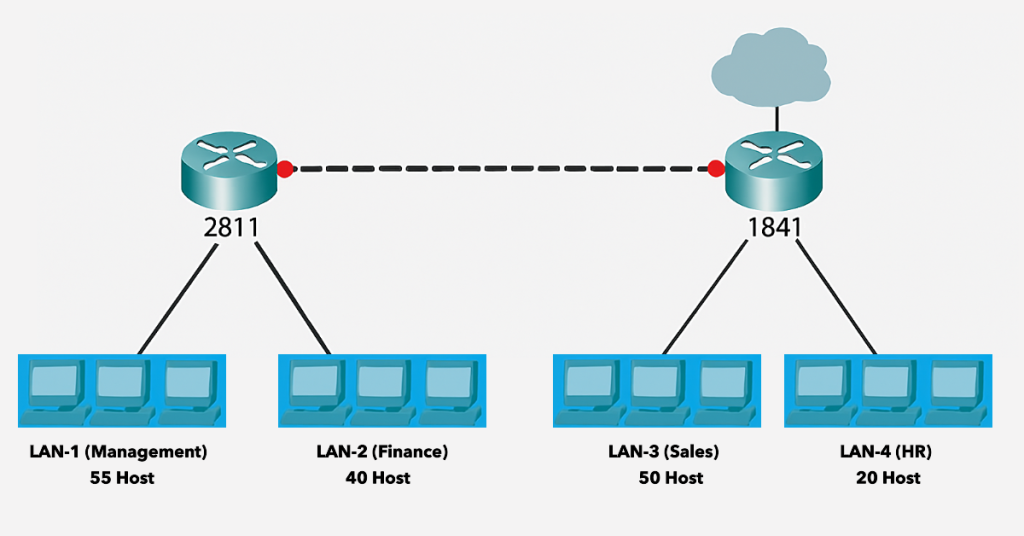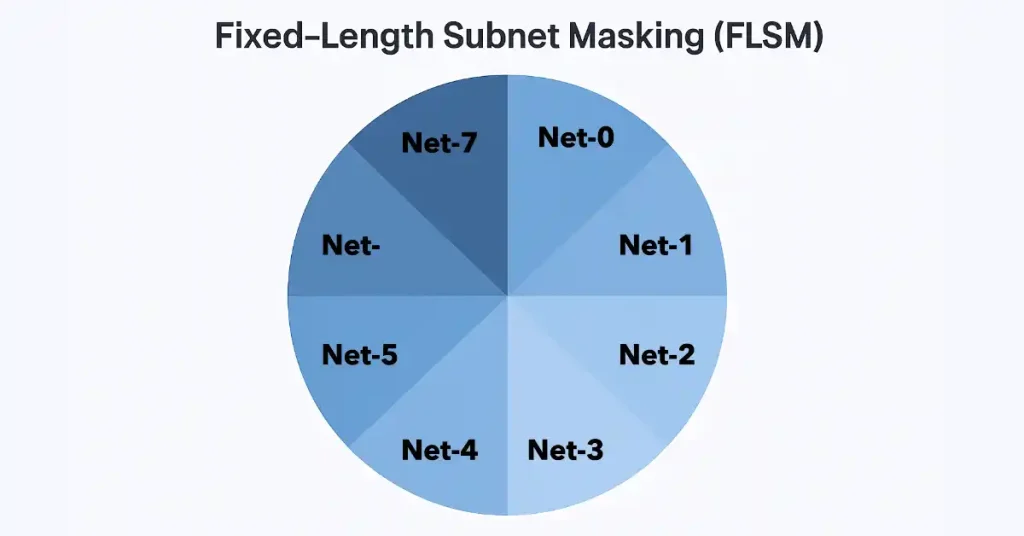Fixed-Length Subnet Masking (FLSM), also known as traditional or classful subnetting, is a foundational concept in IP addressing that CCNA students must master before advancing to more efficient techniques like VLSM in CCNP. In FLSM, an equal number of addresses is allocated to each subnet using a uniform mask length, which simplifies routing in internal networks. This approach works well when all subnetworks have similar host requirements, but it often leads to inefficiencies in real-world scenarios.
For CCNA students, remember that FLSM aligns with classful addressing principles but is extended via CIDR (Classless Inter-Domain Routing) in modern networks. It involves borrowing a fixed number of bits from the host portion of an IP address to create subnets of identical size. This streamlines packet routing by maintaining consistent subnet masks across the network.
What is FLSM?
FLSM allocates equal-sized subnets, simplifying routing tables but often leading to waste. In binary terms, FLSM uses the same subnet mask for all subnets derived from a parent network. For example, starting with a /23 network (which has 9 host bits, allowing 512 addresses total), borrowing 3 bits creates 8 subnets (/26 mask), each with 64 addresses (62 usable hosts after subtracting network and broadcast).
If all subnetworks have similar requirements for the number of hosts, these fixed-size address blocks would be sufficient. However, this is most frequently not the case. The traditional subnetting method wastes IP addresses because the same number of addresses is allocated to each subnetwork, even though the requirements are not similar.

How FLSM Works: Example with 130.10.0.0/23
The topology ( Figure 1 shows a network with four LANs and one WAN link between routers) requires 5 subnets: one for each of the four LANs and one for the WAN connection. Using traditional subnetting with the address 130.10.0.0/23, we borrow 3 bits from the host portion to meet the subnet need (2^3 = 8 subnets, covering the required 5).
Step-by-Step FLSM Calculation
- Determine the Parent Network: 130.10.0.0/23 (mask: 255.255.254.0) has 9 host bits (32 – 23 = 9), providing 2^9 = 512 addresses.
- Calculate Required Subnets: Need 5 subnets; next power of 2 is 8 (borrow 3 bits).
- New Mask: /23 + 3 = /26 (mask: 255.255.255.192).
- Hosts per Subnet: 32 – 26 = 6 host bits; 2^6 – 2 = 62 usable hosts.
- List Subnets: Increment by 64 addresses (2^6 = 64) in the last two octets.
Here’s the subnet allocations:
Net-0
| Type | Address Format |
|---|---|
| Network | 130.10.00000000.00000000 → 130.10.0.0 |
| First | 130.10.00000000.00000001 → 130.10.0.1 |
| Last | 130.10.00000000.00111110 → 130.10.0.62 |
| Broadcast | 130.10.00000000.00111111 → 130.10.0.63 |
Net-1
| Type | Address Format |
|---|---|
| Network | 130.10.00000000.01000000 → 130.10.0.64 |
| First | 130.10.00000000.01000001 → 130.10.0.65 |
| Last | 130.10.00000000.01111110 → 130.10.0.126 |
| Broadcast | 130.10.00000000.01111111 → 130.10.0.127 |
Net-2
| Type | Address Format |
|---|---|
| Network | 130.10.00000000.10000000 → 130.10.0.128 |
| First | 130.10.00000000.10000001 → 130.10.0.129 |
| Last | 130.10.00000000.10111110 → 130.10.0.190 |
| Broadcast | 130.10.00000000.10111111 → 130.10.0.191 |
Net-3
| Type | Address Format |
|---|---|
| Network | 130.10.00000000.11000000 → 130.10.0.192 |
| First | 130.10.00000000.11000001 → 130.10.0.193 |
| Last | 130.10.00000000.11111110 → 130.10.0.254 |
| Broadcast | 130.10.00000000.11111111 → 130.10.0.255 |
Net-4
| Type | Address Format |
|---|---|
| Network | 130.10.00000001.00000000 → 130.10.1.0 |
| First | 130.10.00000001.00000001 → 130.10.1.1 |
| Last | 130.10.00000001.00111110 → 130.10.1.62 |
| Broadcast | 130.10.00000001.00111111 → 130.10.1.63 |
Net-5
| Type | Address Format |
|---|---|
| Network | 130.10.00000001.01000000 → 130.10.1.64 |
| First | 130.10.00000001.01000001 → 130.10.1.65 |
| Last | 130.10.00000001.01111110 → 130.10.1.126 |
| Broadcast | 130.10.00000001.01111111 → 130.10.1.127 |
Net-6
| Type | Address Format |
|---|---|
| Network | 130.10.00000001.10000000 → 130.10.1.128 |
| First | 130.10.00000001.10000001 → 130.10.1.129 |
| Last | 130.10.00000001.10111110 → 130.10.1.190 |
| Broadcast | 130.10.00000001.10111111 → 130.10.1.191 |
Net-7
| Type | Address Format |
|---|---|
| Network | 130.10.00000001.11000000 → 130.10.1.192 |
| First | 130.10.00000001.11000001 → 130.10.1.193 |
| Last | 130.10.00000001.11111110 → 130.10.1.254 |
| Broadcast | 130.10.00000001.11111111 → 130.10.1.255 |
Drawbacks of FLSM
Though traditional subnetting meets the requirements of the largest LAN and divides the address space into enough subnets, it results in a major waste of unused addresses.
For example, only two addresses are required for a WAN subnet. However, each subnet has 62 usable addresses, leaving 60 unused in the WAN subnets. In this example, assume subnet requirements: LAN1 (50 hosts), LAN2 (30 hosts), LAN3 (20 hosts), LAN4 (10 hosts), WAN (2 hosts). Total waste: Approximately 300 addresses out of 512 (e.g., WAN wastes 60, smaller LANs waste varying amounts).
| Subnet | Required Hosts | FLSM Allocation (Usable) | Waste |
|---|---|---|---|
| LAN1 | 55 | 62 | 07 |
| LAN2 | 40 | 62 | 22 |
| LAN3 | 50 | 62 | 12 |
| LAN4 | 20 | 62 | 32 |
| WAN | 2 | 62 | 60 |
This inefficient address utilization is a key limitation of FLSM. It also limits the network’s growth by reducing the total number of subnets available and can bloat routing tables without proper summarization.
| Pros of FLSM | Cons of FLSM |
|---|---|
| Simple to calculate and implement | Wastes IP addresses in uneven networks |
| Uniform routing and easy to understand | Limits scalability for growing networks |
| Aligns with classful boundaries | Inefficient for modern hierarchical designs |
For CCNP, note how this affects route aggregation—FLSM’s fixed sizes make summarization less flexible.
FAQs
What is Fixed-Length Subnet Masking (FLSM)?
FLSM is traditional subnetting where equal addresses are allocated to each subnet using a uniform mask, simplifying routing. It borrows fixed bits from the host portion, like creating 8 /26 subnets from a /23 network, each with 62 usable hosts. Ideal for uniform needs but wasteful otherwise.
How does FLSM work with the example of 130.10.0.0/23?
For a topology needing 5 subnets (4 LANs, 1 WAN), borrow 3 bits from /23 to make /26 subnets. This yields 8 subnets, each with 62 usable hosts, incrementing by 64 addresses (e.g., Net-0: 130.10.0.0 to 130.10.0.63). Follow steps: identify parent network, calculate borrowed bits, and list ranges.
What are the drawbacks of FLSM?
FLSM wastes IP addresses by assigning equal blocks regardless of needs, e.g., a WAN requiring 2 hosts gets 62, wasting 60. In an example with LANs (50-10 hosts) and WAN (2), total waste is ~300 of 512 addresses. It limits growth, bloats routing tables, and hinders flexible summarization in CCNP designs.
What are the pros and cons of FLSM?
Pros: Simple calculation/implement, uniform routing, aligns with classful boundaries. Cons: Wastes IPs in uneven networks, limits scalability, inefficient for hierarchical designs. For CCNP, fixed sizes reduce summarization flexibility, making VLSM preferable for optimization.





